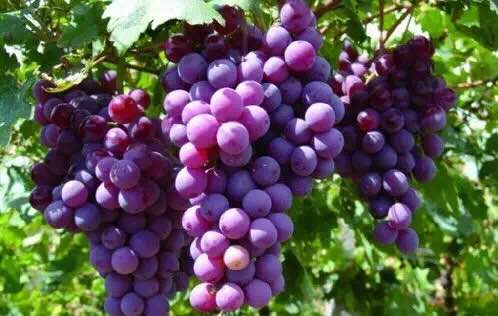Grape Profile
Written by lisa
Nov 09 2020
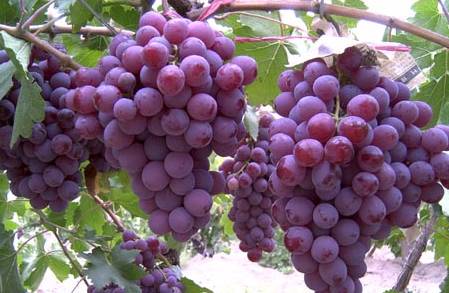
Grapes are woody vines of the Vitis genus Vitis. The branchlets are cylindrical, with longitudinal ribs, glabrous or sparsely pilose, ovoid leaves, dense or sparse panicles, well-developed base branches, and spherical or oval fruit. The flowering period of grapes is from April to May and the fruit period is from August to September.
Grape is one of the oldest fruit tree species in the world. The plant fossils of grapes were found in the tertiary strata, indicating that they had spread throughout Europe, Asia, and Greenland at that time. Grapes are native to western Asia and are cultivated all over the world. About 95% of grapes around the world are concentrated in the northern hemisphere. Grape is a famous fruit, eaten raw or made raisins, and made wine. The tartaric acid can be extracted from the wine after wine. The roots and vines can be used for medicinal purposes to relieve nausea and fetus.
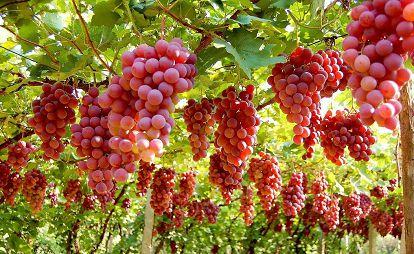
The grape leaves are ovoid, conspicuously 3-5 lobed or mid-lobed, 7-18 cm long, 6-16 cm wide, the middle lobes are sharply pointed at the top, the lobes are often close together, the base is often constricted, the cleavage is narrow, sometimes wide. The base is deep and heart-shaped, the base is concave into a circle, and the sides are often close together. There are 22-27 serrations on the edge. The teeth are deep and thick, irregular, sharply pointed, green on the top, light green on the bottom, without hair or quilt Sparse pilose; basal veins are 5 out, middle veins have 4-5 pairs of lateral veins, and network veins are not prominent. The petioles of grapes are 4-9 cm long and almost glabrous.
The panicles of grapes are dense or sparse, multi-flowered, opposite to the leaves, with well-developed basal branches, 10-20 cm long, peduncle 2-4 cm long, few hairless or sparse spider filamentous hairs; pedicel length 1.5- 2.5 mm, hairless. The flower buds of grapes are obovate, 2-3 mm high, and the top is nearly round; the calyx is shallow dish-shaped, with wavy edges and glabrous outside; petals 5, which are cap-shaped and glued off. The stamens of grapes have 5, filamentous filaments, 0.6-1 mm long, yellow anthers, oval, 0.4-0.8 mm long, significantly short and aborted or completely degenerated in the female flowers. The disc is well developed, 5-lobed; the pistil 1, completely regressed in the male flower, the ovary is ovoid, the style is short, and the stigma is enlarged.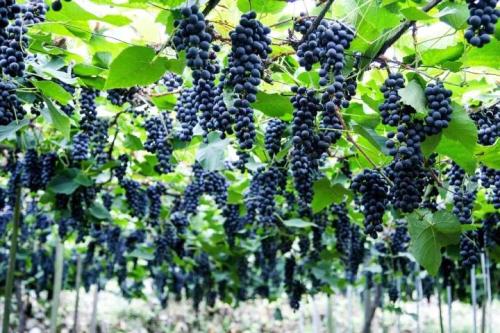
The grapes are native to western Asia and are cultivated all over the world. About 95% of the grapes around the world are concentrated in the northern hemisphere. The main producing areas in China are Xiaoxian in Anhui, Turpan and Hotan in Xinjiang, Yantai in Shandong, Zhangjiakou and Xuanhua in Hebei, etc.
Studies have found that grapes are better at preventing thrombosis than aspirin, lowering human serum cholesterol levels, reducing platelet cohesion, and playing a certain role in preventing cardiovascular and cerebrovascular diseases. Eating a moderate amount of fresh grapes every day will not only reduce the risk of cardiovascular disease but also benefit the health of patients with ischemic heart disease and atherosclerotic heart disease. The flavonoids in fresh grapes can "cleanse" the blood and prevent the formation of cholesterol plaques. The more black the grapes are, the more flavonoids they contain, but if the grape skins and grape seeds are eaten together, the protective effect on the heart is better.
The nursery land should be selected in a place with flat terrain, deep soil, loose and fertile soil, and with irrigation conditions. In the autumn of the first year, the soil is deep-turned 30-40 cm, combined with deep-turning, 3,000-5000 kg of organic fertilizer per 666.7 square meters is applied, and winter irrigation is carried out. After the soil is thawed in early spring, harrow the ground in time to preserve moisture. Cuttings are divided into flat cuttings, high cuttings and ridge cuttings. Flat cuttings are mainly used in drier areas to facilitate irrigation; high cuttings and ridge cuttings are mainly used in areas with relatively humid soil to allow timely drainage and prevent excessive moisture on the surface. When cutting cuttings, care must be taken that the upper end of the cuttings should not be exposed to the ground too long, and at the same time, prevent the cuttings and avoid mixing of varieties.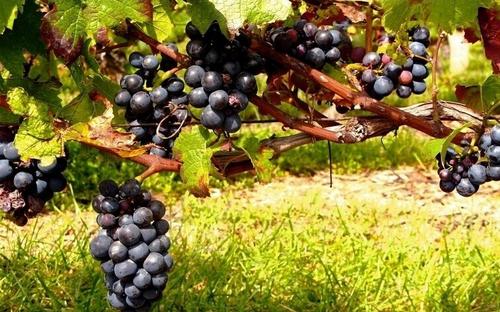 The cutting time starts when the local soil temperature (15-20 cm) stabilizes above 10°C. In North China, it is generally from late March to early April, but open-field cuttings can only be carried out in mid-April in northern North China.
The cutting time starts when the local soil temperature (15-20 cm) stabilizes above 10°C. In North China, it is generally from late March to early April, but open-field cuttings can only be carried out in mid-April in northern North China.
After grape cuttings and before new roots are produced, the soil must be prevented from drought. Generally, water is watered once every 10 days. Watering the heavy soil should be done less frequently. If you water too much, the soil will be too wet and the ground temperature will decrease. Poor soil aeration will also affect the rooting of the cuttings. Strengthen fertilizer and water management after cuttings take root. Seedlings enter the rapid growth stage in early and mid-July, at this time quick-acting fertilizer should be applied 2-3 times. In order to make the branches fully mature, irrigation and fertilization should be stopped or reduced from late July to August. At the same time, the prevention of diseases and insect pests should be strengthened, and the main shoots and auxiliary shoots should be topped to ensure the healthy growth of grape seedlings. During the growth period of seedlings, it is necessary to plow and weed in time to improve soil aeration and promote the growth of grape roots.
Grape is one of the oldest fruit tree species in the world. The plant fossils of grapes were found in the tertiary strata, indicating that they had spread throughout Europe, Asia, and Greenland at that time. Grapes are native to western Asia and are cultivated all over the world. About 95% of grapes around the world are concentrated in the northern hemisphere. Grape is a famous fruit, eaten raw or made raisins, and made wine. The tartaric acid can be extracted from the wine after wine. The roots and vines can be used for medicinal purposes to relieve nausea and fetus.
Grape PicturesGrape morphological characteristicsGrape growth habit and growing environment and distributionTemperatureMoistureIlluminationSoilGrape efficacy and roleGrape cultivationCutting propagation
Grape Pictures

Grape morphological characteristics
The branchlets of grapes are cylindrical, with longitudinal ribs, glabrous or sparsely pilose. The tendrils are bifurcated and branched, intermittently opposite to the leaves every two nodes.The grape leaves are ovoid, conspicuously 3-5 lobed or mid-lobed, 7-18 cm long, 6-16 cm wide, the middle lobes are sharply pointed at the top, the lobes are often close together, the base is often constricted, the cleavage is narrow, sometimes wide. The base is deep and heart-shaped, the base is concave into a circle, and the sides are often close together. There are 22-27 serrations on the edge. The teeth are deep and thick, irregular, sharply pointed, green on the top, light green on the bottom, without hair or quilt Sparse pilose; basal veins are 5 out, middle veins have 4-5 pairs of lateral veins, and network veins are not prominent. The petioles of grapes are 4-9 cm long and almost glabrous.
The panicles of grapes are dense or sparse, multi-flowered, opposite to the leaves, with well-developed basal branches, 10-20 cm long, peduncle 2-4 cm long, few hairless or sparse spider filamentous hairs; pedicel length 1.5- 2.5 mm, hairless. The flower buds of grapes are obovate, 2-3 mm high, and the top is nearly round; the calyx is shallow dish-shaped, with wavy edges and glabrous outside; petals 5, which are cap-shaped and glued off. The stamens of grapes have 5, filamentous filaments, 0.6-1 mm long, yellow anthers, oval, 0.4-0.8 mm long, significantly short and aborted or completely degenerated in the female flowers. The disc is well developed, 5-lobed; the pistil 1, completely regressed in the male flower, the ovary is ovoid, the style is short, and the stigma is enlarged.
Grape growth habit and growing environment and distribution
Temperature
The minimum temperature required for grape growth is about 12℃-15℃, the lowest ground temperature is about 10℃-13℃, the optimum temperature for the flowering period is about 20℃, and the optimum temperature for the fruit expansion period is 20℃-30℃. If the temperature difference between day and night is large, the coloring and sugar content are better. After the grapes sprout in spring. If the temperature rises quickly, it will easily cause the branches to grow longer, which is manifested as the length of the knots is not full, and the flowering period is prone to poor fertilization. If the spring is cold, pay attention to applying more phosphate fertilizer and high-carbon organic matter, and minimize nitrogen fertilizer.Moisture
Grapes have high requirements for moisture, and strict control of soil moisture is a prerequisite for good grapes. Grapes require a lot of water in the early or vegetative growth period. In the later or fruiting period, the roots are weaker and require less water. Avoid root damage to avoid affecting the quality. Grapes avoid rain and dew. Rainy years can easily cause insufficient sunlight and limited photosynthesis. Excessive water absorption can easily lead to long branches and high humidity, which can easily cause various diseases, such as black pox and gray mold. Therefore, it is best to keep the branches at 40-70 cm during the flowering period of grapes; the irrigation amount during the fruiting period in the areas prone to cracking fruit should also be controlled. In water-deficient and drought-prone areas, appropriate padding of straws should be used to maintain soil moisture and also to control grass growth.Illumination
During the normal growth period, grapes must have a certain intensity of light, but when the light is too strong, especially when the grapes enter the hard-core period, sunburn is more likely to occur. At this time, bagging or plant leaves can be retained as much as possible to cover the grapes. Fruit leaves. Insufficient sunlight can easily cause poor corolla shedding during the flowering period and low fertilization rate; poor differentiation of flower buds during flower bud differentiation and more parthenocarpic fruits; long plants and long internodes during the growth period. No fruit or parthenocarpic fruit; disease and poor quality during fruit expansion; poor coloration at maturity and decreased sugar content.
Soil
Although grapes can be cultivated in various soils, loam and fine sandy loam are the best, although sandy soil has good air permeability. But the ability to retain fertilizer and water is poor. Loam is between sandy soil and clay soil. Its water and fertilizer retention capacity is strong, and most of them are more fertile. When the grapes are growing vigorously, they are more prone to blooming and parthenocarpy. When the high temperature and light conditions are good, the fruit is good and the yield is high. When the low temperature and sunshine are not enough, the results are not good and the yield is low; usually pay attention to drainage, avoid exploration tillage, light pruning in winter and more pruning in summer, and spray borax, potassium dihydrogen phosphate and superphosphate. Clay soil has poor air permeability, but it retains fertilizer and water better, and nutrient decomposition and absorption are slower. There are less prolongation, flow flowers and parthenocarpic in the early stage, but it is prone to prolongation in the later stage of development. Although the grapes have large ears and grains, the sugar content and meat quality are often not good. More high-carbon organic matter or a small amount of sand should be added to improve the acid soil. It is best to neutralize the acid soil with an appropriate amount of lime.The grapes are native to western Asia and are cultivated all over the world. About 95% of the grapes around the world are concentrated in the northern hemisphere. The main producing areas in China are Xiaoxian in Anhui, Turpan and Hotan in Xinjiang, Yantai in Shandong, Zhangjiakou and Xuanhua in Hebei, etc.
Grape efficacy and role
Grapes are not only delicious but also have high nutritional value. The sugar content of grapes in ripe berries is as high as 10%-30%, mainly glucose. A variety of fruit acids in grapes help digestion. Eat more grapes appropriately to strengthen the spleen and stomach. Grapes contain minerals such as calcium, potassium, phosphorus, iron, vitamin B1, vitamin B2, vitamin B6, vitamin C and vitamin P, etc. It also contains a variety of amino acids needed by the human body. Often eating grapes is good for neurasthenia and excessive fatigue. Helpful.Studies have found that grapes are better at preventing thrombosis than aspirin, lowering human serum cholesterol levels, reducing platelet cohesion, and playing a certain role in preventing cardiovascular and cerebrovascular diseases. Eating a moderate amount of fresh grapes every day will not only reduce the risk of cardiovascular disease but also benefit the health of patients with ischemic heart disease and atherosclerotic heart disease. The flavonoids in fresh grapes can "cleanse" the blood and prevent the formation of cholesterol plaques. The more black the grapes are, the more flavonoids they contain, but if the grape skins and grape seeds are eaten together, the protective effect on the heart is better.
Grape cultivation
Cutting propagation
After the stored grape branches are taken out of the ditch in the spring, they are soaked indoors in clean water for 6-8 hours, and then cut. Generally cut the branches into cuttings with 2-3 buds. The cuttings are generally about 20 cm long, and the varieties with long internodes only leave 1-2 buds on each cutting. When cutting cuttings, the upper end is flat cut 1 cm above the bud, and the lower end is cut diagonally below the bud. The grape bud eye on the upper part of the cuttings should be full and full. If the first bud eye is damaged after cutting, the second bud eye can germinate, which will help improve the survival rate of cuttings.The nursery land should be selected in a place with flat terrain, deep soil, loose and fertile soil, and with irrigation conditions. In the autumn of the first year, the soil is deep-turned 30-40 cm, combined with deep-turning, 3,000-5000 kg of organic fertilizer per 666.7 square meters is applied, and winter irrigation is carried out. After the soil is thawed in early spring, harrow the ground in time to preserve moisture. Cuttings are divided into flat cuttings, high cuttings and ridge cuttings. Flat cuttings are mainly used in drier areas to facilitate irrigation; high cuttings and ridge cuttings are mainly used in areas with relatively humid soil to allow timely drainage and prevent excessive moisture on the surface. When cutting cuttings, care must be taken that the upper end of the cuttings should not be exposed to the ground too long, and at the same time, prevent the cuttings and avoid mixing of varieties.

After grape cuttings and before new roots are produced, the soil must be prevented from drought. Generally, water is watered once every 10 days. Watering the heavy soil should be done less frequently. If you water too much, the soil will be too wet and the ground temperature will decrease. Poor soil aeration will also affect the rooting of the cuttings. Strengthen fertilizer and water management after cuttings take root. Seedlings enter the rapid growth stage in early and mid-July, at this time quick-acting fertilizer should be applied 2-3 times. In order to make the branches fully mature, irrigation and fertilization should be stopped or reduced from late July to August. At the same time, the prevention of diseases and insect pests should be strengthened, and the main shoots and auxiliary shoots should be topped to ensure the healthy growth of grape seedlings. During the growth period of seedlings, it is necessary to plow and weed in time to improve soil aeration and promote the growth of grape roots.
Latest Updated
- Benefits of Bugleweed - 7 Science-backed Health Benefits
- Bugleweed Dangers & Side Effects - Is It Poisonous?
- How to Plant Evergreen Trees - What You Should Know
- When to Plant Evergreens - Grow Guide for Evergreen Trees
- 12 Wonderful Evergreen Shrubs for Your Garden
- 12 Popular Evergreen Plants with Pictures for Beginners
- When And How To Prune A Lilac Bush Like a Pro
- How to Grow & Care for Lilac Vine (Hardenbergia Violacea)
- Japanese Lilac Tree (Syringa Reticulata) Care & Propagation Guide
- Shumard Oak Pros and Cons - What to Know
Popular Articles
- Winter maintenance of Antirrhinum Majus
- How to Grow Terminalia Mantaly Tree
- How to Grow and Care for Crossostephium Chinense
- How to grow Antirrhinum Majus in spring
- Peristeria Elata (Dove Orchid) Profile: Info & Care Guide
- Underwatered Snake Plant (Sansevieria Trifasciata) - Signs And How To Fix
- How to Care for Brazilian Jasmine Plant (Mandevilla Sanderi)
- How to Grow & Care for Graptopetalum Purple Delight in Summer
- Rosa Chinensis (China Rose): Plant Growing & Care Tips
- How to Care for Baby Sun Rose (Aptenia Cordifolia)
